In the decade that he ran Aquacopia, he successfully mobilized $200 million to create a number of projects: including the offshore farm Open Blue, which is currently producing around 2,000 tonnes of cobia a year in the Gulf of Mexico; an equipment innovation firm, InnovaSea, which created the Aquapod cage; and a feed ingredient group, iCell/Nutrinsic.

However, he reveals, he is now looking for fresh aquacultural opportunities – with developing technology for producing alternative sources of protein amongst his key target areas.
“Since the first half of 2016, I have been seeking assets to acquire, independently, as the basis for a start-up. In essence, I’ve been running a search fund that uniquely focuses on aquaculture technology. It has already found desirable targets in alternative protein ingredients for aquaculture feeds,” he explains.
Tze is relishing the change of focus and, after a decade in the business, believes he is well placed to tackle any challenges.
“I am now changing roles, from entrepreneurial financier to finance-minded entrepreneur, from coach to player. This move represents a return towards the first eight, pre-aquaculture years of my career, on the start-up/operator side. Although my bio elides failures and challenges, be assured they took place and were learned from,” he asserts.
And he is currently evaluating a number of technologies.
“After significant winnowing, the current crop of technology prospects that I am actively evaluating consists of four alternative proteins for aquaculture feeds. Of them, one is a distressed patent portfolio, two are companies, and one is a solo inventor. The identities and nature of these technology prospects are trade secrets. Within those four, initial funding needs are as high as $10 million, but run lower by almost two orders of magnitude,” he reflects.
He is clear why bulk protein ingredient for inclusion in formulated aquafeeds is his primary target.
"An eligible ingredient would provide some advantage in cost and/or performance, around one of several interesting price points. Such technologies may have meaningful intellectual property and may be highly scalable, high margin, based on products that can be quantitatively valued based on their nutritive capabilities, while also being a broad way to play the aquaculture sector without betting on just a few species, countries, or production methods,” he observes.
Tze is not without alternative protein experience – iCell/Nutrinsic’s IP relates to the production of sustainable, high-grade proteins that can serve as a fishmeal replacement in aquafeeds and the venture has developed a patented process for generating such high-quality single cell proteins for feed from aqueous waste/byproducts that originate from beer breweries.
And he believes that the recent fish-free feed competition, the F3 Challenge – which offers $200,000 dollars to the first company that is able to produce 100,000 tonnes of fish-free aquafeeds – demonstrates that he is looking in the right field.
“The recent alternative ingredients for aquaculture meeting, hosted by the Fish-Free Feed Challenge, is the most recent and visible signal of coalescing interest in our area,” said Tze. “While I predict our ultimate ingredient will improve both fish-bearing and fish-free feeds, the F3 Challenge served as final confirmation of the top priority of this alternatives sub-category for my search fund.”

